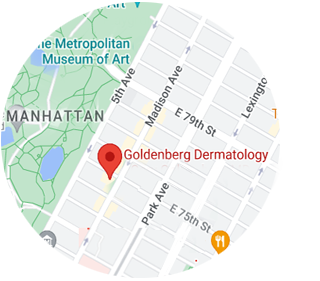
Early detection and treatment of skin cancer have been one of the most significant advances in dermatologic surgery in the past decade. An average skin cancer patient has a “spot” that is changing. Sometimes it is “a bump that won’t heal”, “a mole that changed color” or “a sore that is bleeding”. Other times it is a mole that is growing, bleeding, or itching. Doctors Gary and Kristina Goldenberg are board-certified dermatologists and experts in early diagnosis and treatment of skin cancer. Dr. Gary Goldenberg is also a recognized dermatopathologist and is able to visualize what lesions would look like under the microscope, giving him a deep understanding of each lesion he examines.
Common skin cancers include basal cell carcinoma, squamous cell carcinoma, and melanoma. Of all types of skin cancer, basal cell carcinoma is the most common. Fortunately, they tend to grow slowly and remain localized. They frequently appear on sun-exposed parts of the body. Common appearances of a basal cell include a fleshy bump with a pearly surface, a scar-like lesion, or a bump that bleeds. A more severe but less frequent type of skin cancer is known as squamous cell carcinoma. It frequently appears as a scaly, red patch, or nodule that grows. Common locations include the nose, ears, hands, and scalp (especially in men that have lost their hair). Early diagnosis and treatment are key to preventing any skin cancer from growing into melanoma, which is a potentially fatal disease.
Malignant melanoma is the most serious type of common skin cancer. Typically, it appears as a mole that changes size, bleeds, or begins to itch. Most melanomas are asymmetric due to cells growing at different rates. Many have an irregular border, are more than one color, and have a diameter of more than 5 mm. Early detection and prompt intervention by a dermatologist are the best treatment for melanoma.
Basal Cell Carcinoma
Basal cell carcinoma is the most common cancer in humans. Fortunately, they tend to grow slowly and remain localized. Chronic exposure to sun and UV rays are a major contributing factor for all basal cell carcinomas. It is not a coincidence that they tend to occur most frequently on the face, ears, neck, scalp, shoulders, and back. Basal cell carcinoma can masquerade as acne bumps, eczema lesions, or scars. Some telling signs that a spot on your skin might be a basal cell carcinoma include: an open sore, a reddish patch, a shiny bump or nodule, a pink growth, and a scar-like area. These lesions tend to bleed and may be itchy. Basal cell carcinoma usually doubles in size every year but is usually curable, especially if detected and treated early. As with other forms of skin cancer, the age of onset is decreasing and the rate of incidence in women is rising. Basal cell carcinoma skin cancers have increased over the past few decades, and the average age of onset of the disease has steadily decreased.











